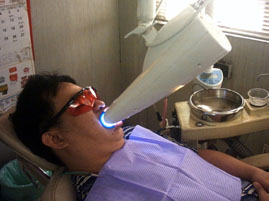
 |
Information You Should Know About Teeth BleachingWHAT IS TEETH BLEACHING / WHITENING?
Clinical Procedure
There are two main ways to bleach teeth:A. Using Dental Trays, similar to mouth-piece worn around teeth
2. Plaster models are made from these moulds and then trays to cover the teeth are made from the models. 3. A small amount of bleaching solution or gel is placed in the trays to be worn over the teeth.
The trays are worn over the teeth for a period of one and a half to six hours daily for about 3 weeks, with visits to the dentist scheduled every week. There is also a method where the solution/gel uses a less than concentrated formula than the first mixture above. In this case the patient will wear the trays overnight for about a week or so or until it lightens to the desired effect.
B. Laser method, and more popular method· A safe bleaching solution is applied to the teeth and exposed to a small intense light (Laser machine) that activates the bleach. · After the above steps are repeated 2-4 times, the teeth are then polished. · Procedure only requires 60 minutes.  About the Bleaching Material:What results would one expect after bleaching: The results mostly last up to 3 years and treatment will be required again, depending on the food habit intake of the patient. It is successful in at least 90% of the patients. For the first procedure: Most people have noticeable whitening of teeth in 1-2 weeks after treatment. However for deeper stains, e.g. those caused by tetracycline, acceptable results will be attained only after several weeks of treatment. For the second procedure: Results are usually immediate and dramatic. However, the cost is more than the first type.
Possible Side Effects:No one can predict how much lighter your teeth will become. The success rate depends upon the type of stain and your compliance. Bleaching only provides a shift in color from gray to a lighter shade of gray, for example. Bleaching does not lighten artificial materials such as resins, silicates or porcelains, hence; restorations and crowns may needed to be changed to match the new shade.
|
||||
|
|
|
|
|
|